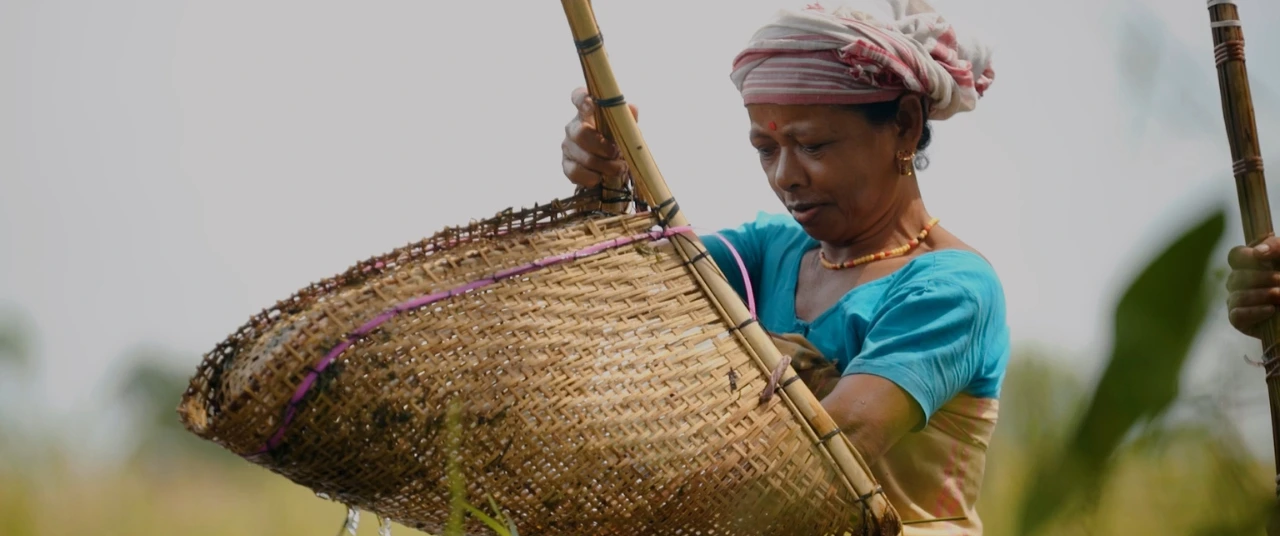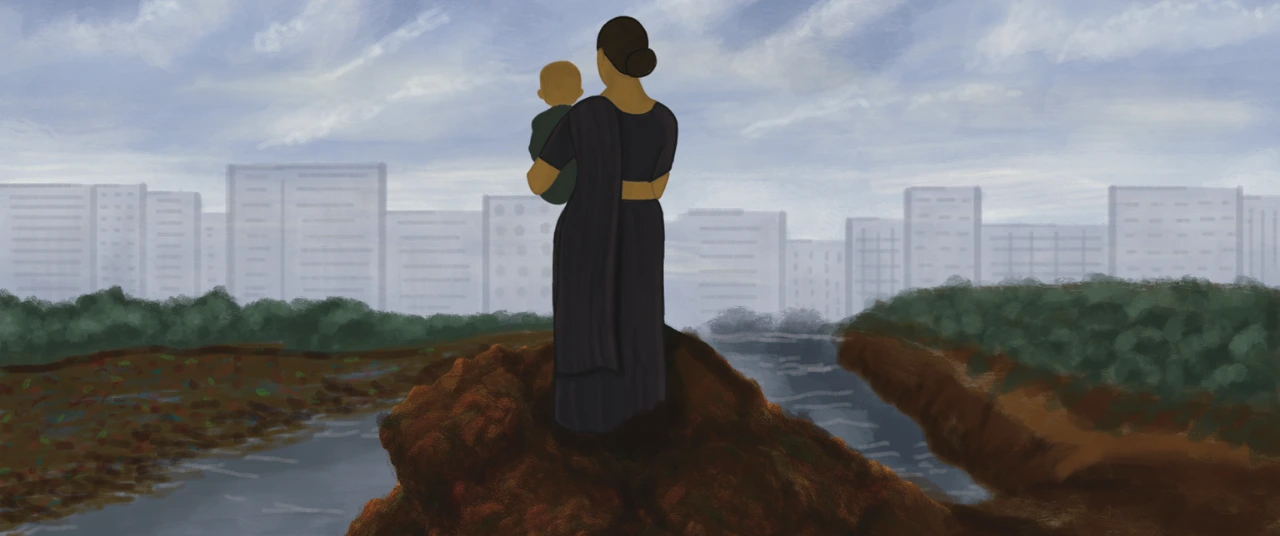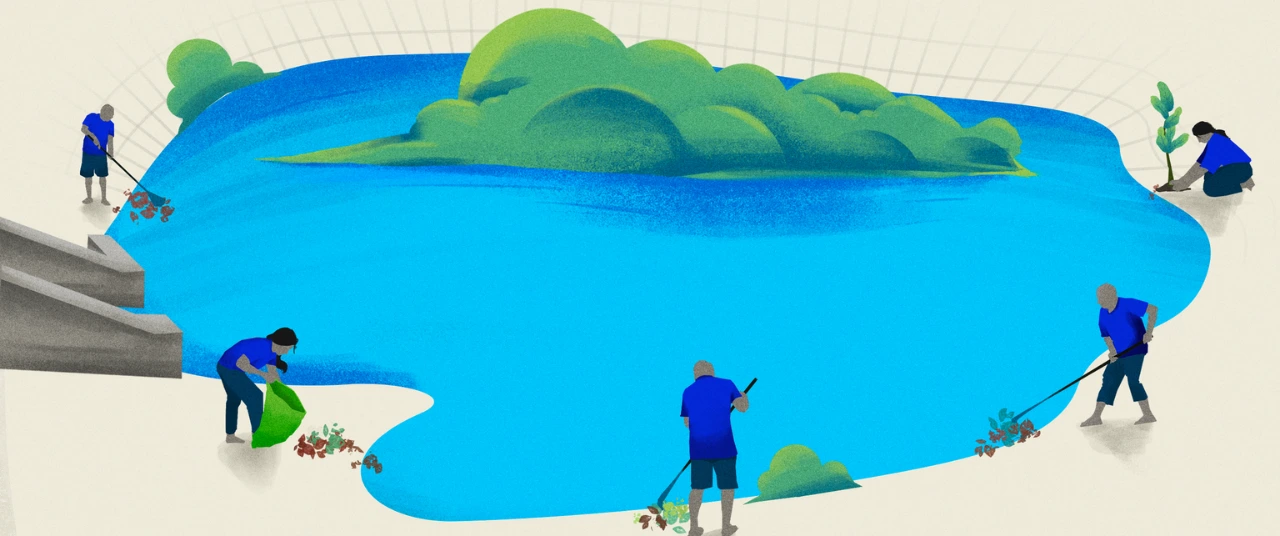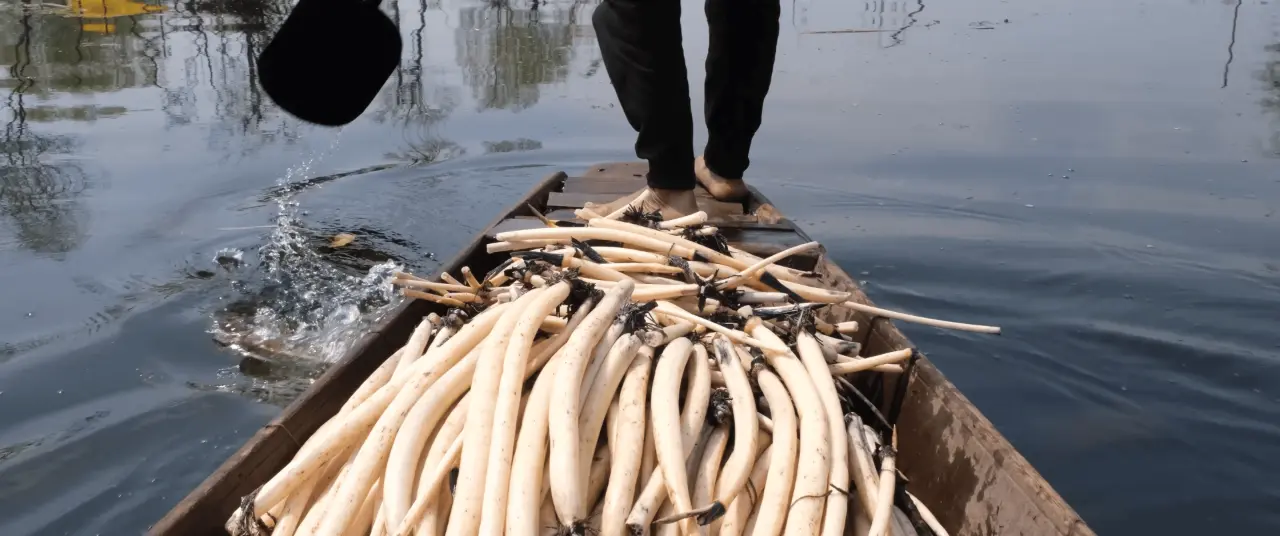Wastewater can be treated and distilled into a completely safe form. But gaps exist in implementation, public acceptance






Editor’s note: The last two decades have been witness to the rapid and devastating march of unchecked urbanisation and climate change in India’s cities. Among the first victims of this change is freshwater and access to it—from rivers which sustained local ecosystems, to lakes and groundwater which quenched the thirst of residents. In this series, the Good Food Movement examines the everyday realities of neglect and pollution. It documents the vanishing and revival of water bodies, and community action that made a difference.
The sweat on your brow, the dew on a leaf, the droplets lingering on your umbrella—all evaporate, condense into clouds, and return to the Earth as rain. They make themselves at home in rivers, seas, wells, aquifers and the like. Ultimately, they make their way back to you, flowing from the taps you use to wash your face, to the streams you dip your feet into. The story of the water cycle is the story of the oldest, most consistent system of recycling this essential natural resource.
Recycled water makes a comeback
As the 1970s rolled around, the climate crisis really unveiled itself. This is when reusing water became an environmentally conscious thing to do. But long before that, people in Greece, Yemen, and closer home in the Indus Valley had the same idea: they were also connecting homes to drains, and drains to sewers, and sewers to agricultural fields. Such sanitation practices stayed relevant, and in fact, proved all the more important after several water-borne epidemics ravaged parts of the world. In the mid-19th century, for instance, European cities were planned in a way that the urban sewage would drain into nearby agricultural land, aptly named 'sewage farms'. But eventually, the growing density of populations and the increase in human settlements reduced the land available for agriculture, and other avenues had to be found to get rid of wastewater and sewage. Herein emerged septic tanks, contact beds, and trickling filters (the latter two use layers of microbes to filter and clean water) that allowed treated wastewater to be directly fed to freshwater sources.
The return of recycled water is owed to various factors, but it mainly ties into pollution, our depleting groundwater sources, increasingly irregular weather, and the growing fear that we might run out of water.
In the 20th century, these technologies became sophisticated, and one could now recycle large volumes of water in compact spaces. Urban areas spilled into rural ones, and the need to move wastewater to agricultural lands shrunk. The idea of reclaiming nutrients from used water for farming became arcane.
Now, we are inching back towards exploring the potential of recycled water. In late 2019, Chennai launched two Tertiary Treatment Reverse Osmosis (TTRO) plants that purify sewage water to the same quality as raw freshwater. In the town of Devanahalli, Karnataka, thousands have been receiving recycled drinking water since August 2023. In its annual civic budget for 2025-26, the Brihanmumbai Municipal Corporation (BMC) allocated Rs 5,545 crore for constructing seven advanced tertiary treatment plants (ATTPs) in Mumbai, which serve the same purpose.
The return of recycled water is owed to various factors, but it mainly ties into pollution, our depleting groundwater sources, increasingly irregular weather, and the growing fear that we might run out of water.
Also read: Bengaluru is fated to run out of water. When will the crisis hit?
Know the status quo
Turn the tap, turn it back. Water gushes and retreats like magic, and we never pause to decode the magician's trick. Where does the water come from? Well, it depends on where you come from. In their paper published in 2015, researchers Mihir Shah and Himanshu Kulkarni proposed a 6 x 4 matrix to understand a city's relationship with its water.
Imagine a city as a cell: we start with a small nucleus (stage I), the centre of development. The cell grows (stage II) and expands (stage III) into suburbs and peri-urban areas. Finally, some cities either expand their boundaries significantly or merge with a satellite city (stage IV). These 4 stages comprise the first axis of this matrix. At each stage, the water supply system morphs and builds upon its former self. While a growing township starts out relying on private wells and borewells, as it grows it formalises into a system of pipelines and tankers.
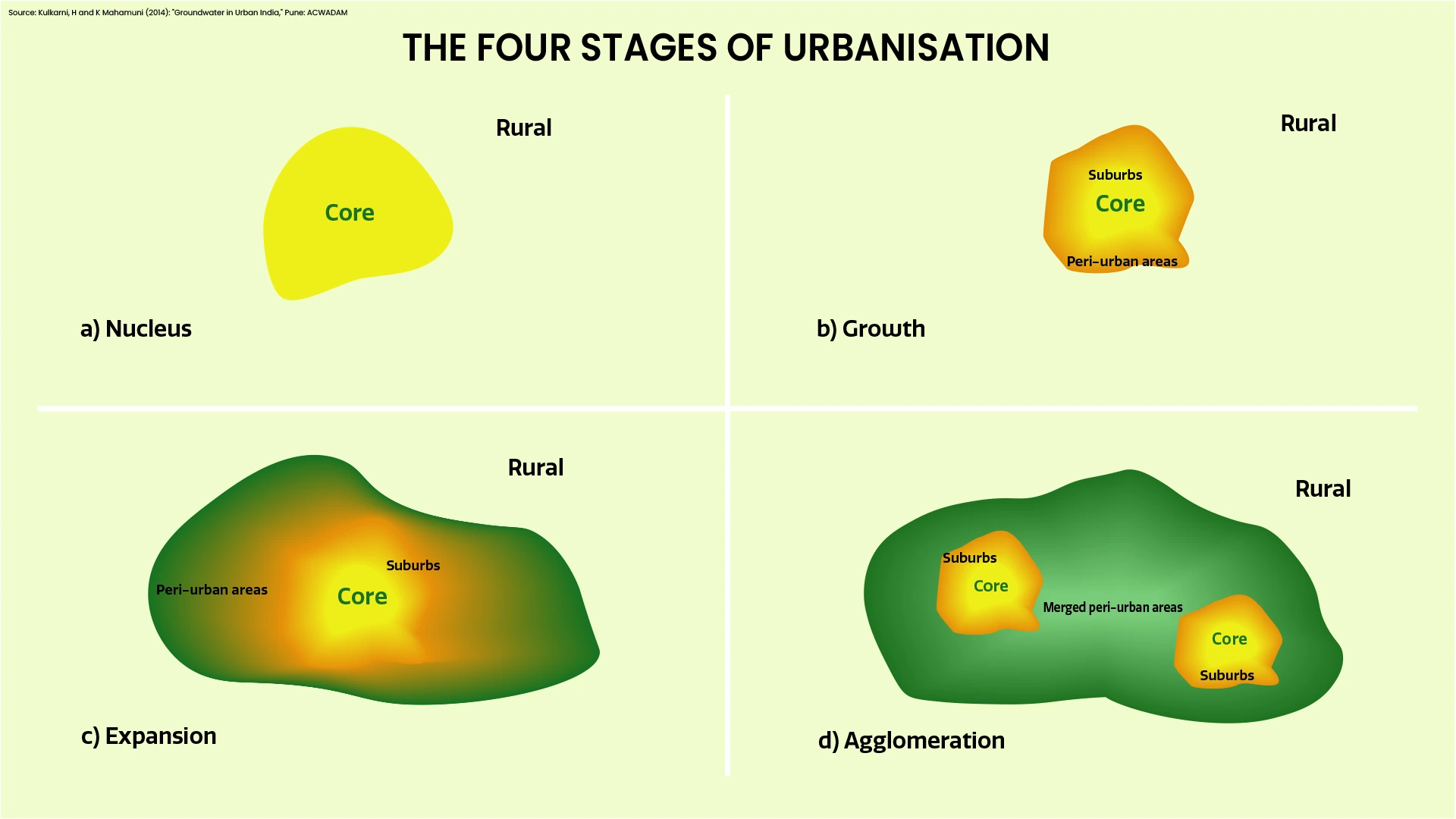
However, water infrastructure in India tends not to catch up with expanding cities. The nucleus continues to receive formally established public water supply, while suburbs tend to source water privately through tankers, and those on the very periphery may continue getting their water from private borewells.
For example, in Bengaluru, large parts of the city receive either Kaveri water or groundwater through the Bangalore Water Supply and Sewerage Board (BWSSB). However, the BWSSB does not yet have a presence in the periphery of the city, where residents instead turn towards private tankers or local borewells. Similarly, one’s socio-economic strata plays a role in water access. A slum's notified or unnotified status dictates its access to BWSSB supplies, even if it is located in an area with the requisite infrastructure.
The other axis of this matrix documents six geological classifications of aquifers—underground layers of rock that can store groundwater, like natural reservoirs—in India based on their quality and capacity to transmit and store water. For example, in the Himalayan ranges, aquifers flow across several villages and towns, while most of south India has crystalline rock that has low storage capacity.
The BWSSB currently has 33 STP plants that treat around 1350 million litres of sewage daily before emptying it into storm water drains.
Ultimately, whether in pipes or through tankers, your water comes from rivers, lakes, or wells fed by rivers and lakes. Once it goes down your drain, this water changes its identity, having now become dirty from the processes of cleaning it was used for. In areas where the municipal sewerage board supplies water, it also takes responsibility for the sewerage—by and large. Apartments over 120 units in BWSSB sewerage networks and apartments over 20 units outside of BWSSB sewerage networks are responsible for installing their own Sewage Treatment Plants or STPs.
The BWSSB currently has 33 STP plants that treat around 1350 million litres of sewage daily before emptying it into storm water drains. Apartments, however, are mandated to reuse the treated wastewater. Predominantly, this water is used for flushing and landscaping. Senior hydrologist at WELL Labs, Shashank Palur, shares that excess recycled water is often illegally discarded into storm water drains, too. However, last year during the water shortage in Bengaluru, the Bangalore Apartments’ Federation (BAF) convinced the Environmental Ministry to allow apartments to offer up to 50% of their treated wastewater on sale, provided that they use the remaining half.
A crash course in STPs
To be fit for gardening and flushing, water undergoes two levels of treatment. At the primary level, machinery is used to break down large particles and then separate out particulate matter through sedimentation. At the secondary level, microbes are used to digest organic contaminants like nitrates. The latter is a dynamic process, requiring constant supervision. "That's where the most maintenance and operational cost is," explains Shashank Palur.
However, there is only so much water that can be used for gardening and flushing. A survey of over 200 apartments by Boson Whitewater found that only 20% of recycled water is used for non-potable purposes. The rest is usually discarded or, if permitted, resold.
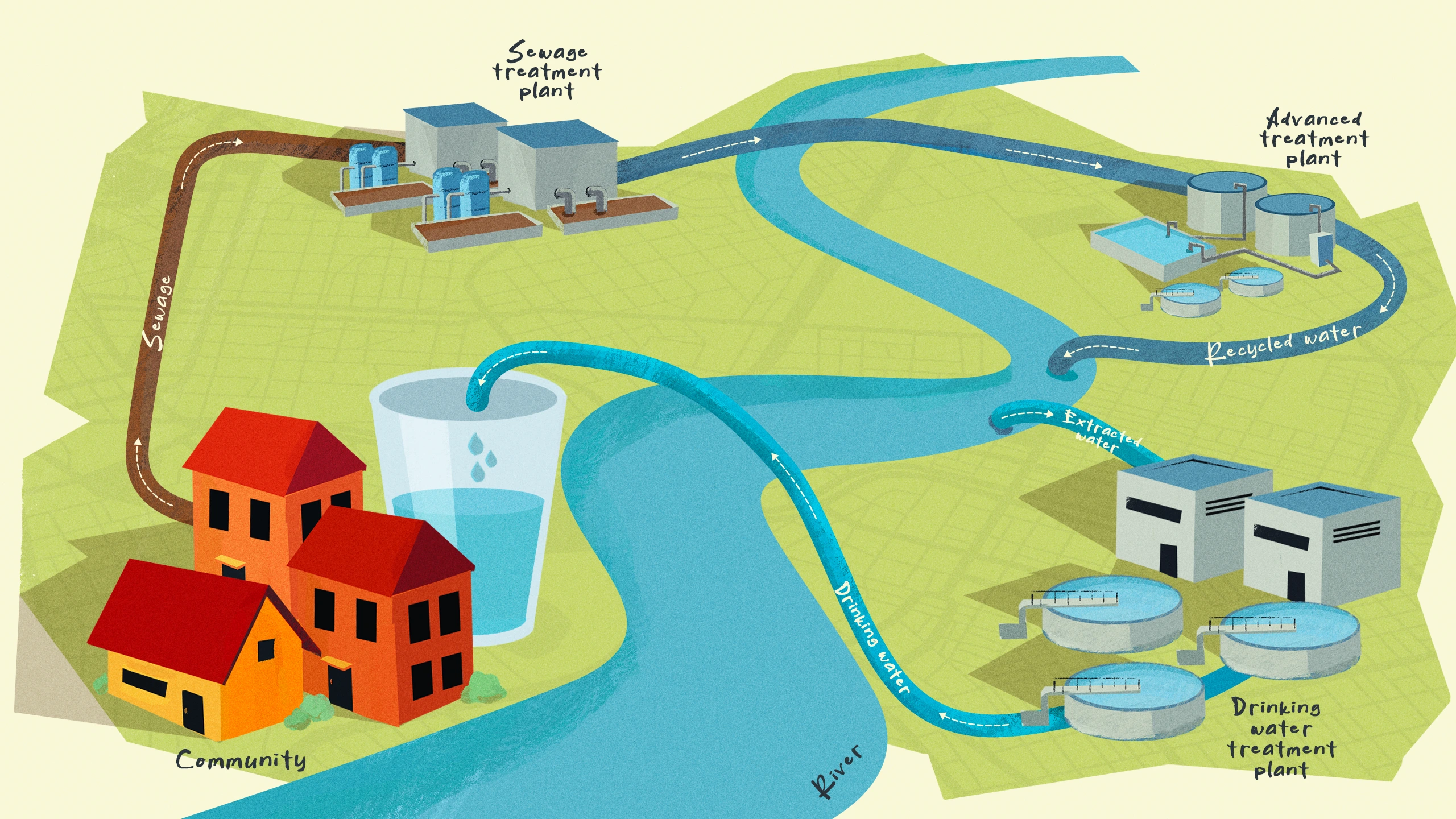
If we want to do more with our wastewater, we need to treat it further. Most STPs set up by apartments are only capable of secondary treatment of wastewater. The next round is cost-intensive, and requires added, trained personnel. Charcoal or sand filters are considered the baseline for any tertiary treatment, but they are often supplemented with reverse osmosis (RO), ultrafiltration (UF), ultraviolet light (UV), and chlorination. Each of these methods target different kinds of impurities, and are often used in conjunction with each other. For example, chlorine and charcoal filters are often paired together in water purification systems. Chlorine effectively removes most bacteria and viruses, but is itself harmful for us in large amounts; charcoal filters effectively remove chemicals like chlorine, thus protecting from the negative byproducts created during the purification process. But the silver bullet of water purification is RO: it removes everything, from viruses to dissolved solids and even the natural minerals of water, resulting, practically, in distilled water. Most RO filters are accompanied by a mineral bed to add back necessary minerals into drinking water.
These internal variations in any tertiary treatment process mean that tertiary treated water cannot automatically be declared potable—it needs to be tested to meet certain requirements and safety standards.
However, public animosity to the idea of treated wastewater comes from more than just the ‘yuck’ factor felt while drinking it.
At the national level, the Union Ministry for Consumer Affairs, Food and Public Distribution sets guidelines through the Bureau of Indian Standards. Currently, two standards pertain to drinking water: IS 10500:2012, and IS 17482:2020. The former pertains to drinking water quality specifications, while the latter covers the management of drinking water supply systems.
The BIS 10500 tests water for 6 physical characteristics, 24 chemicals, and 12 toxic substances. Moreover, water must also be tested for radioactive substances and pesticides. For most parameters there is an acceptable limit for these characteristics, and a permissible limit in the absence of alternate sources. For some parameters, like radioactive substances, there is no relaxation even in the absence of an alternate source. If water quality is below the acceptable limit, then despite the absence of alternate sources, that source should not be used to supply drinking water anymore.
However, the BIS is a standard and not a law. This means that while a conscientious supplier can obtain a certificate proving the quality of water supplied, it cannot be enforced for all suppliers. This lack of enforceability is exacerbated by the fact that water supply is a State subject. While the Centre can nudge the states in a certain direction (as the Jal Jeevan Mission does), it must leave enforcement in the hands of individual states. More recently, the government has also released the draft of the Liquid Wastewater Management Draft (effective from October 2025) which includes expected percentage of wastewater reuse for various kinds of establishments.
Also read: In Gurugram’s rise, a cautionary tale about satellite cities and groundwater
Potable pathways
Two roads diverge in a yellow wood, and potable treated water cannot travel both. The choice, in this case, lies between Direct Potable Reuse (DPR), and Indirect Potable Reuse (IPR).
Direct Potable Reuse is when the water goes through primary, secondary, and tertiary treatment and is directly piped into the water supply system after spending a meagre 24 hours in a man-made environmental buffer. As a drought-prone country, Namibia was one of the first countries to embrace direct potable reuse through the Goreangab Water Reclamation Plant in Windhoek. Since its inception in 1968, residents have reported no adverse health effects from the consumption of recycled water. Yet, DPR has had to make way for its more popular sibling, the IPR.
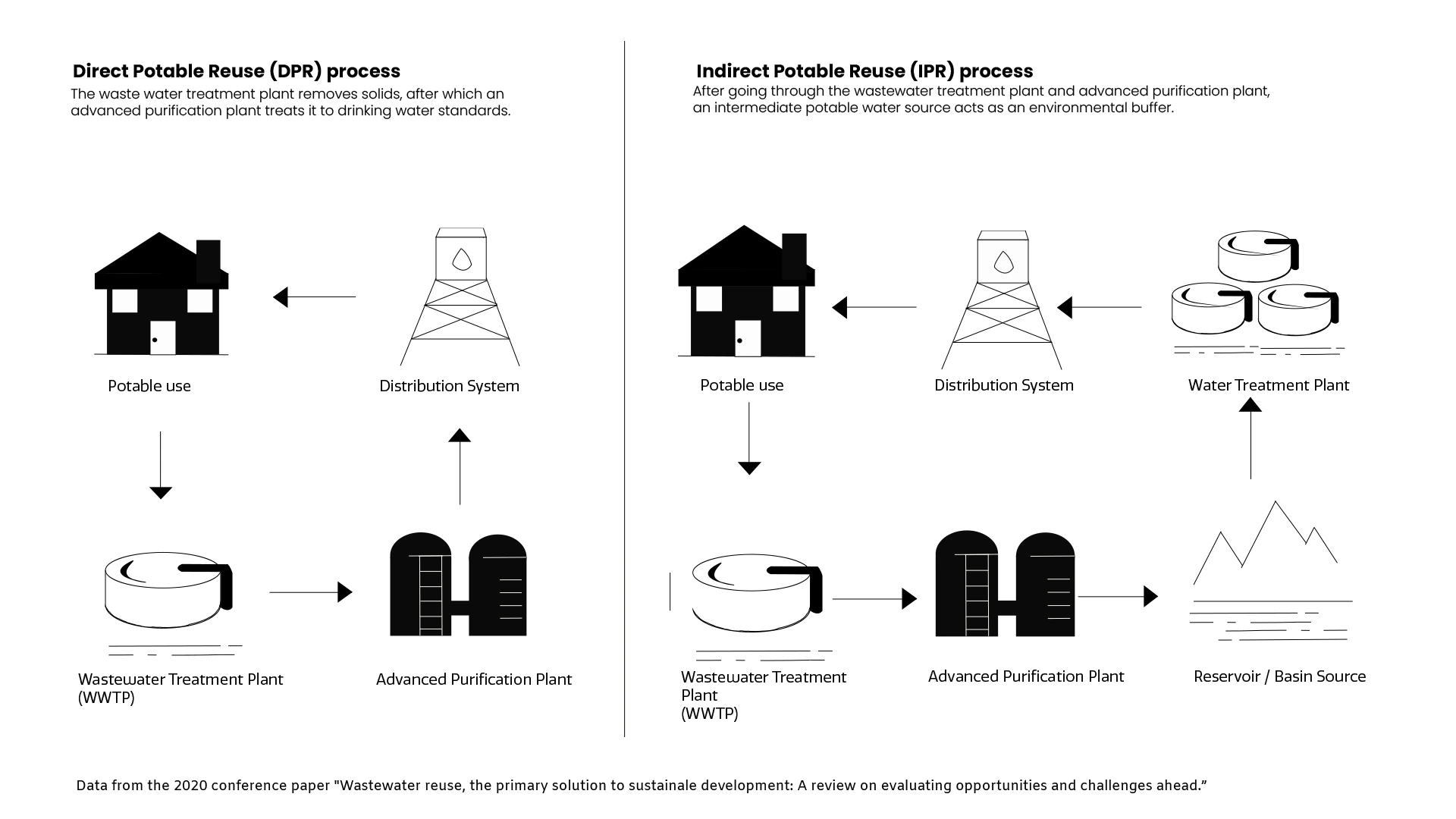
There are different ways to embark on Indirect Potable Reuse, but by definition, they all involve a natural environmental buffer. The idea is to naturalise water by mixing it with sources of ground or surface water, as well as rain. Sewage water supplied by Chennai city is currently emptied into lakes after treatment and then pulled out for water supply. Palur shares how this is, in fact, counterproductive. "It is known that the quality of water right out of the STP is way better than what comes out of the lake, because the lake has some legacy contamination. That's why, again, they have to put up a water treatment plant next to the lake which pumps the water in and then sends it to people."
This extra step is a response to public discomfort with the idea of drinking treated wastewater; most administrators find it easier to placate people by undertaking an additional level of treatment from the environmental buffer rather than attempting to supply treated water directly. This explains why IPR projects are found far more commonly than their DPR counterparts—even though generally, it is more expensive to treat wastewater through this process.
However, the Devanahalli town of Karnataka has found a more purposeful way of undertaking indirect potable reuse. Its municipality has married the causes of recycled water with lake and aquifer rejuvenation. Diluted treated wastewater is first introduced into Bagalur lake, then rediluted in Sihi Neerukere, and lastly diluted by the earth when it enters the well. Then it goes through a water treatment plant before entering the water supply system. However, for such an indirect potable reuse system to work, there is one non-negotiable requirement: clean lakes and wells. The first thing the Devanahalli municipality did was to clean its lakes and wells, such that it can receive treated wastewater and dilute it with clean surface water and rainwater. Now, multiple tests have attested that Devanahalli’s treated water complies with BIS 10500 standards.
This extra step is a response to public discomfort with the idea of drinking treated wastewater; most administrators find it easier to placate people by undertaking an additional level of treatment from the environmental buffer rather than attempting to supply treated water directly.
“The water that the Devanahalli town was supplying to the town before did not meet drinking water standards, because there was no choice. But now, we are making sure that it is meeting drinking water standards,” shares Vishwanath S, director of Biome Environmental Trust, who provided technical knowledge to the Devanahalli town municipal corporation for this project.
Worldwide, across multiple projects, public response has been a big make-or-break factor in treating and consuming treated water. It only makes sense that the WHO 2017 guidelines have a separate section dedicated to ‘The Art of Public Engagement’ with real-life case studies in tow.
However, public animosity to the idea of treated wastewater comes from more than just the ‘yuck’ factor felt while drinking it. There have been, for instance, plenty of reports detailing the emptying of raw sewage into rivers by STPs, instead of treating it. Small semantic adjustments like calling wastewater ‘used water’ can help with this. But the most obscure obstruction is the lack of public trust in the administration to undertake these processes faithfully, transparently, and correctly. Disillusionment with governments in a policy like this can come at the cost of implementation, and many administrators have had to abandon projects like these. Generally, a policy of transparency is recommended where public backlash is anticipated.
This is where Singapore’s NEWater project took the bull by the horns. In 2003, they introduced a water museum, live tours of the factory through a gallery, and got the political leadership to use their packaged water in public.
In all this, it can help to revisit the philosophy of Dr Lukas van Vuure, one of the pioneers on the Windhoek plant, who is remembered for the quote: “Water should be judged by its quality, not by its history.”
Also read: The intertwined fate of Navi Mumbai’s Kolis and the Kasardi river
Cover art by Prabhakaran S
Produced by Nevin Thomas and Neerja Deodhar
{{quiz}}
Explore other topics
References



.avif)

.avif)
